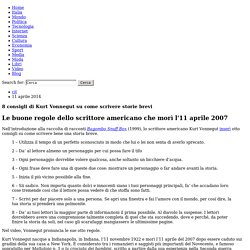

Kurt Vonnegut’s Cat’s Cradle to become a TV show. According to the late celebrated author and satirist Kurt Vonnegut, Cat’s Cradle is tied with Slaughterhouse-Five as Kurt Vonnegut’s best book with a grade of “A-plus.”

Given that the latter was treated to its own film version in 1972, its co-winner is long overdue for an adaptation. Better late that never, as they say: IM Global Television has optioned the rights to Cat’s Cradle, and the series will be executive produced by Sandi Love of Elkins Entertainment and Brad Yonover. Released in 1963, the original work is Vonnegut’s fourth novel. It follows a narrator named John who gets involved in the lives of the adult children of Felix Hoenikker, a fictional co-creator of the atomic bomb. Through the family he learns about ice-nine, a way to freeze water at room temperature that could, in theory, destroy the world. Very few details about the show have been revealed at this point, but we’re hoping it turns out better than the film version of Breakfast Of Champions. Kurt Vonnegut Diagrams the Shape of All Stories in a Master’s Thesis Rejected by U. Chicago.
“What has been my prettiest contribution to the culture?”

Asked Kurt Vonnegut in his autobiography Palm Sunday. His answer? His master’s thesis in anthropology for the University of Chicago, “which was rejected because it was so simple and looked like too much fun.” The elegant simplicity and playfulness of Vonnegut’s idea is exactly its enduring appeal. The idea is so simple, in fact, that Vonnegut sums the whole thing up in one elegant sentence: “The fundamental idea is that stories have shapes which can be drawn on graph paper, and that the shape of a given society’s stories is at least as interesting as the shape of its pots or spearheads.”
The presenter who introduces Vonnegut's short lecture tells us that “his singular view of the world applies not just to his stories and characters but to some of his theories as well.” Related Content: The Shape of A Story: Writing Tips from Kurt Vonnegut. The Universal Shapes of Stories, According to Kurt Vonnegut. 8 consigli di Kurt Vonnegut su come scrivere storie brevi. Nell’introduzione alla raccolta di racconti Bagombo Snuff Box (1999), lo scrittore americano Kurt Vonnegut inserì otto consigli su come scrivere bene una storia breve. 1 – Utilizza il tempo di un perfetto sconosciuto in modo che lui o lei non senta di averlo sprecato.2 – Da’ al lettore almeno un personaggio per cui possa fare il tifo3 – Ogni personaggio dovrebbe volere qualcosa, anche soltanto un bicchiere d’acqua.4 – Ogni frase deve fare una di queste due cose: mostrare un personaggio o far andare avanti la storia.5 – Inizia il più vicino possibile alla fine.6 – Sii sadico.

Non importa quanto dolci e innocenti siano i tuoi personaggi principali, fa’ che accadano loro cose tremende così che il lettore possa vedere di che stoffa sono fatti.7 – Scrivi per dar piacere solo a una persona. Se apri una finestra e fai l’amore con il mondo, per così dire, la tua storia si prenderà una polmonite.8 – Da’ ai tuoi lettori la maggior parte di informazioni il prima possibile.
Al diavolo la suspense. Kurt Vonnegut graphed the world’s most popular stories. This post comes via Know More, Wonkblog's social media site.

Kurt Vonnegut claimed that his prettiest contribution to culture wasn’t a popular novel like “Cat’s Cradle” or “Slaughterhouse-Five,” but a largely forgotten master’s thesis he wrote while studying anthropology at the University of Chicago. The thesis argued that a main character has ups and downs that can be graphed to reveal the taxonomy of a story, as well as something about the culture it comes from.
“The fundamental idea is that stories have shapes which can be drawn on graph paper, and that the shape of a given society’s stories is at least as interesting as the shape of its pots or spearheads,” Vonnegut said. In addition to churning out novels, Vonnegut was deeply interested in the practice of writing. The tips he wrote for other writers – including “How to write with style” and “Eight rules for writing fiction” -- are concise, funny, and still very useful. Maya Eilam.
8 consigli di Kurt Vonnegut su come scrivere storie brevi. Kurt Vonnegut spiega la struttura di Cenerentola.